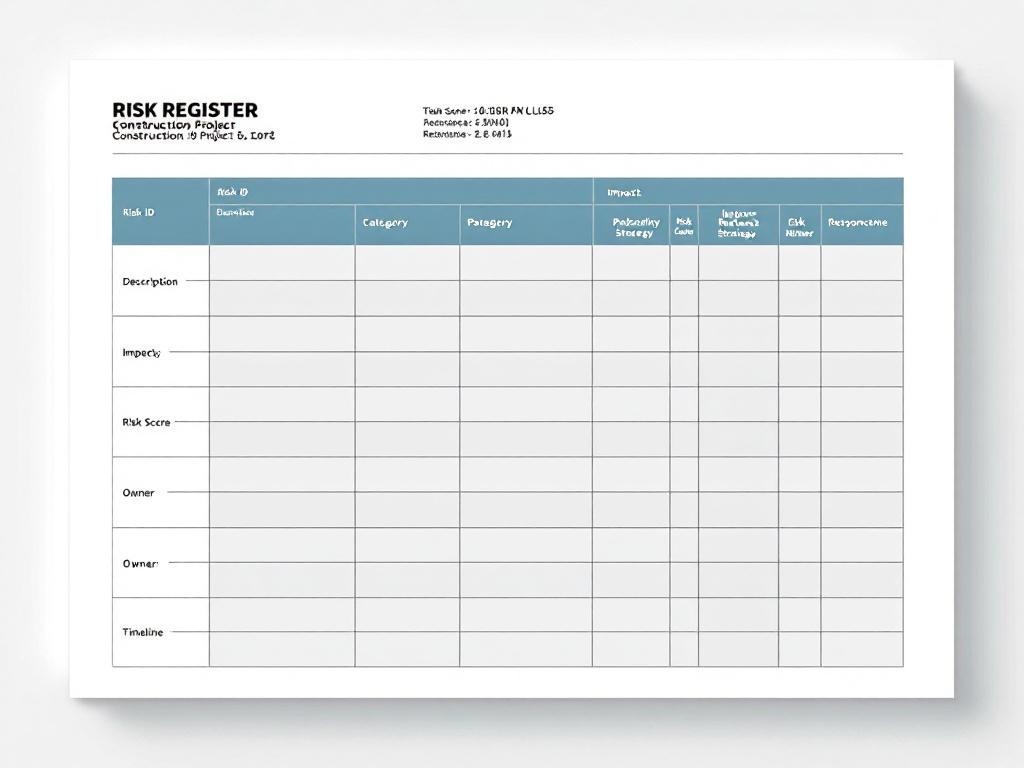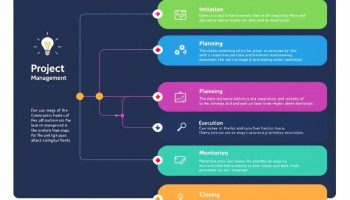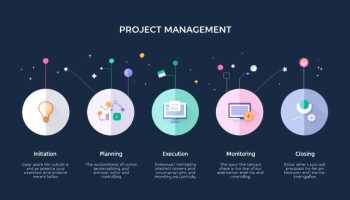
A comprehensive construction project risk register example serves as a critical tool for proactively managing potential threats and opportunities throughout a project’s lifecycle. This strategic document provides a structured approach to identifying, assessing, and mitigating risks by capturing essential components such as risk ID, description, probability, impact, and response strategies across various project domains.
Key Takeaways
- A well-designed risk register includes detailed components like risk identification, probability ratings, impact assessments, and specific response strategies.
- Effective risk management requires consistent rating scales and regular team reviews to maintain project control.
- Risk identification should involve diverse team perspectives, historical data analysis, and expert consultations.
- Risk response strategies include mitigation, avoidance, transfer, acceptance, and exploitation of potential opportunities.
- Successful risk management is a dynamic process that requires continuous monitoring and adaptive planning.
What Is a Construction Project Risk Register?
A construction risk register acts as a central database that tracks all identified risks on your project. This essential risk management tool documents potential problems before they occur and outlines specific action plans to address them.
Your risk register typically includes:
- Unique risk identifiers
- Detailed risk descriptions
- Probability assessments
- Impact evaluations
- Ownership assignments
- Mitigation strategies
- Implementation timelines
Maintaining an updated register helps you anticipate challenges, allocate resources efficiently, and communicate effectively with stakeholders about potential issues.
Key Components of an Effective Construction Risk Register
The effectiveness of your risk register depends on its thoroughness. Include these critical elements:
Risk Identification
Each risk needs a unique ID number and clear description. Categorize risks by type (financial, safety, schedule, quality) to organize them effectively. This identification process forms the foundation for all subsequent risk management activities.
Probability Rating
Assign probability ratings using a consistent scale (1-5 or Low-Medium-High). Base these ratings on historical data, expert judgment, and team input. A standardized approach ensures your team evaluates risks consistently.
Impact Assessment
Evaluate the potential consequences of each risk on cost, schedule, quality, and safety. Use your established rating scale to quantify these impacts. Consider both direct and indirect effects to capture the full scope of each risk.
Risk Score Calculation
Calculate risk scores by multiplying probability by impact. This prioritization helps you focus resources on the most significant threats. Higher scores indicate risks that demand immediate attention.
Response Strategy
Develop specific response strategies for each identified risk. Your options include:
- Mitigation: Actions to reduce probability or impact
- Avoidance: Changes to eliminate the risk entirely
- Transfer: Shifting responsibility through insurance or contracts
- Acceptance: Acknowledging minor risks with contingency plans
- Exploitation: Capitalizing on positive risks (opportunities)
Ownership and Timeline
Assign responsibility for each risk to specific team members. Establish clear deadlines for implementing response strategies and monitoring outcomes. This accountability ensures risks don’t fall through the cracks.
Construction Project Risk Register Example
Review this sample risk register format to guide your own development:
| Risk ID | Description | Category | Probability (1-5) | Impact (1-5) | Risk Score | Response Strategy | Owner | Timeline |
|---|---|---|---|---|---|---|---|---|
| R-001 | Material price increases exceeding 10% | Financial | 4 | 4 | 16 | Transfer: Include price escalation clauses in contracts | Procurement Manager | Before contract signing |
| R-002 | Unexpected ground conditions during excavation | Technical | 3 | 5 | 15 | Mitigation: Conduct additional geotechnical surveys | Chief Engineer | Before excavation |
| R-003 | Key subcontractor bankruptcy | Commercial | 2 | 5 | 10 | Mitigation: Financial pre-qualification and backup vendors | Contracts Manager | Quarterly review |
| R-004 | Permit approval delays | Regulatory | 3 | 4 | 12 | Avoidance: Early application with complete documentation | Project Manager | 3 months before needed |
| R-005 | Adverse weather conditions | Environmental | 4 | 3 | 12 | Acceptance: Schedule buffer in critical path activities | Planning Engineer | Monthly review |
Best Practices for Risk Register Implementation
Creating and maintaining an effective risk register requires strategic planning and consistent execution. Follow these proven approaches:
Comprehensive Risk Identification
Gather diverse team perspectives through structured brainstorming sessions. Analyze similar past projects for relevant risk data. Consider consulting external experts for specialized input on complex risks.
Regular Review and Updates
Schedule weekly or bi-weekly risk review meetings with key team members. Update probability and impact ratings based on changing project conditions. Add new risks as they emerge and close risks that no longer apply.
Clear Communication Channels
Share the risk register with all stakeholders in an accessible format. Establish protocols for reporting new risks or changing conditions. Use visual dashboards to highlight critical risks requiring immediate attention.
Integration with Project Controls
Link your risk register to your schedule and budget management systems. Incorporate risk responses into your project plan as specific activities. Track the effectiveness of implemented response strategies.
Risk management is an ongoing process that adapts as your project evolves. By maintaining a detailed and current risk register, you’ll gain better control over project outcomes and demonstrate professional foresight to clients and stakeholders.
“A comprehensive risk register is not just a document; it’s a strategic lifeline that empowers project teams to anticipate and navigate uncertainties with precision. By fostering collaboration and ongoing assessment, it transforms potential threats into opportunities for success throughout the project’s lifecycle.”
Structure and Components of an Effective Risk Register
Your construction project risk register example needs several key elements to effectively track and manage potential issues. A well-structured risk register serves as your central repository for identifying, assessing, and monitoring risks throughout your project lifecycle.
A comprehensive construction project risk register example typically includes these essential components:
- Risk ID: Assign unique identifiers (R-001, R-002) for easy reference and tracking
- Risk Description: Provide detailed explanation of the potential threat or opportunity
- Risk Category: Classify by type (schedule, budget, quality, safety, resources)
- Probability Rating: Estimate likelihood of occurrence (Low/Medium/High or 1-5 scale)
- Impact Assessment: Evaluate severity on project objectives (cost, time, quality)
- Risk Score/Priority: Calculate combined value from probability and impact
- Response Strategy: Document your approach (mitigate, avoid, transfer, accept)
- Action Plan: List specific steps and timeline for implementation
- Risk Owner: Designate responsible team member
- Status: Track current state (open, in progress, closed, escalated)
- Triggers: Identify early warning signs requiring action
Sample Construction Risk Register Format
Here’s how these components might appear in a construction project risk register example:
| Risk ID | Description | Category | Probability | Impact | Score | Response | Action Plan | Owner | Status |
|---|---|---|---|---|---|---|---|---|---|
| R-001 | Adverse weather delaying foundation work | Schedule | Medium (3) | High (4) | 12 | Mitigate | 1. Monitor weather forecasts 2. Prepare contingency schedule 3. Arrange temporary weather protection |
Site Manager | Open |
| R-002 | Subcontractor bankruptcy | Resource | Low (2) | High (4) | 8 | Transfer | Include performance bonds in contracts | Procurement | Closed |
| R-003 | Material price increases beyond 5% | Budget | High (4) | Medium (3) | 12 | Share | Negotiate cost-sharing clause with client | Project Manager | In Progress |
When creating your construction project risk register example, you should implement consistent rating scales for both probability and impact. This approach ensures your team can develop appropriate risk response strategies based on objective measurements.
Regular risk register reviews are essential for effective project assurance. Schedule weekly team meetings to update the register, reassess priorities, and verify mitigation actions are being implemented.
Your construction project risk register example should remain a living document, continuously updated as new risks emerge and existing ones evolve. This dynamic approach helps you maintain control over project constraints while providing transparency to stakeholders about how risks are being managed.

Risk Identification and Assessment Methodologies
Identifying and assessing risks effectively can make or break your construction project. You’ll need to employ multiple techniques simultaneously to create a comprehensive construction project risk register example that captures all potential threats and opportunities.
Start with brainstorming sessions that include diverse team members from different disciplines. These collaborative meetings help uncover risks that might be overlooked by individuals working in isolation. Include your architects, engineers, contractors, financial team, and even client representatives to gain varied perspectives.
Consult with subject matter experts who understand construction-specific challenges. Their specialized knowledge can identify technical risks that generalists might miss. For example, a structural engineer might spot potential foundation issues in challenging soil conditions before they become problems.
Analyzing historical data from similar projects provides valuable insights into what might go wrong. Review the risk registers, lessons learned, and project closure reports from comparable construction projects to identify patterns and recurring issues.
SWOT analysis (Strengths, Weaknesses, Opportunities, Threats) offers a structured framework for comprehensive risk profiling. This method helps you identify both internal and external factors that could impact your project.
When assessing identified risks, combine likelihood and impact ratings to produce meaningful risk scores. A typical approach uses a risk matrix (3×3 or 5×5) to visualize priority levels. Here’s an example risk scoring matrix for your construction project risk register:
| Probability/Impact | Low (1) | Medium (2) | High (3) |
|---|---|---|---|
| High (3) | 3 | 6 | 9 |
| Medium (2) | 2 | 4 | 6 |
| Low (1) | 1 | 2 | 3 |
This scoring system helps you allocate resources to the most critical risks. For instance, risks scoring 6-9 might require immediate attention and detailed risk response planning, while those scoring 1-2 might simply need monitoring.
Your assessment should incorporate both qualitative judgments (expert opinions) and quantitative measures (statistical probabilities, financial impacts) whenever possible. For construction projects, quantifying potential schedule delays or cost overruns provides tangible metrics for decision-making.
Common Construction Risk Categories
When creating your construction project risk register example, organize risks into these categories to ensure comprehensive coverage:
- Safety and health risks (accidents, injuries, compliance issues)
- Financial risks (cost overruns, funding problems, cash flow disruptions)
- Schedule risks (delays, resource availability, weather impacts)
- Quality risks (defects, rework, material failures)
- Contractual risks (disputes, claims, procurement issues)
Effective risk identification and assessment forms the foundation of construction risk management. By systematically applying these methodologies, you’ll develop a robust construction project risk register that helps you anticipate and manage challenges before they impact your project.

Risk Response and Mitigation Planning
Your construction project risk register example must include comprehensive response strategies to effectively manage identified risks. Developing appropriate risk responses involves selecting the most suitable tactics to address each construction project risk register example and creating detailed implementation plans.
Primary Response Strategies
When managing construction risks, you’ll need to select from these five fundamental response strategies:
- Mitigation: Actions that reduce either likelihood or impact of risks. For example, you might implement additional safety protocols, conduct more frequent site inspections, or utilize alternative construction methods to minimize specific hazards.
- Avoidance: Modifications to your project plan that completely eliminate risk sources. This could involve changing construction techniques, selecting different materials, or redesigning problematic elements before they become issues.
- Transfer: Shifting risk impact to third parties through contracts, insurance, or performance bonds. Common examples include subcontractor agreements with penalty clauses, specialized insurance coverage for high-risk activities, or performance guarantees.
- Acceptance: Acknowledging minor risks where response costs outweigh potential impacts. This requires setting aside contingency reserves for accepted risks that might occur.
- Exploitation: For positive risks (opportunities), taking actions to ensure benefits are realized, such as leveraging innovative construction methods or materials that might improve project outcomes.
Each construction project risk register example should document the selected strategy along with a detailed action plan specifying:
- Specific preventive or contingent actions
- Required resources and budget allocations
- Timeline for implementation
- Key performance indicators to measure effectiveness
- Trigger conditions that activate contingency plans
For effective planning, your risk response planning should be proportionate to the risk level. High-priority construction risks warrant more detailed mitigation plans, while low-priority risks might receive simpler monitoring approaches.
A well-structured construction project risk register example will link each risk to specific response owners who possess the authority, expertise, and resources to implement the chosen strategies. This accountability ensures risks don’t fall through cracks during project execution.
When implementing responses, you should regularly reassess effectiveness through monitoring key indicators and adjusting strategies as needed. The construction project risk register example serves as your living document throughout this process, tracking the evolution of risks and response effectiveness over time.
Nearly 70% of construction projects experience delays, with risk management being a crucial factor in maintaining timelines and budgets.
forbes.com






